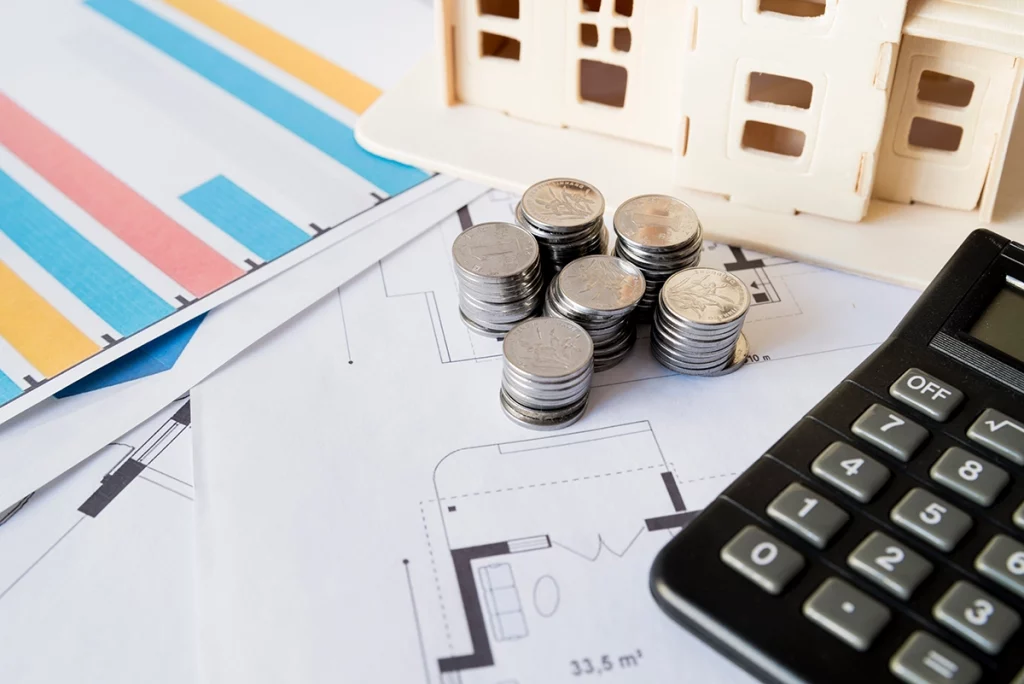When it comes to construction projects, using cost per square foot is one of the most commonly used ways to estimate the cost of the work. It’s a simple way to compare costs across different projects or to “ballpark” expenses. However, it’s important to understand where the limitations of this approach are. In this article, I’ll discuss the definition of cost per square foot and how it’s used in construction.
Cost per square foot to construct a home or building
The cost per square foot for a building is simply determined by dividing the total construction cost by the total area of the building. This usually only includes conditioned space, i.e. the space within the thermal envelope that’s either heated or cooled.
The way it’s typically used in estimating a project is by multiplying the area of the building by the cost per square foot that is appropriate for that type of building.
(Cost per sq ft) x (Total Gross Square Feet) = Cost of Construction
This “appropriate” cost per square foot is determined most often by using historical data, recent project costs, and cost-estimating books or software from a company like RSMeans.
A square foot cost is determined by a range of factors like the quality of finishes, number of stories, foundation types, exterior materials, etc.
Another important factor in determining construction costs is the location of the project. Construction costs can vary widely across the country; the cost to build a house in Texas might be 50% less than the cost to build a house near New York City. Things like climate or the availability of labor and materials all factor in.
Once an appropriate cost per square foot is determined based on the qualities of the house or building, it can be applied to the total square footage to get the estimated cost of construction. This metric is used to estimate the costs of construction (as opposed to project cost), and it’s a good starting point for discussing budgets early in the design phase.
What does it include?
The cost per square foot for estimating construction includes all of the costs associated with the construction of the building not necessarily the entire project. So, this includes things like materials, labor, permits, and the contractor’s overhead and profit.
Also, it typically only includes the costs of construction for conditioned spaces, meaning any space within the building envelope that is heated or cooled. Make sure to check with your builder to see if things like a porch, garage, or full basement are included.
What doesn’t it include?
The cost per square foot for an entire building does not include any costs associated with financing, design, or project management.
- Soft costs
- Land
- Site preparation
- Septic
- Outbuildings like sheds, carports, and pool houses
- Detached garages
- Driveways and sidewalks
- Landscaping
- Furniture
Since there is no “official” way to assemble a square foot estimate, there is a chance that some of these items may have been included in the estimate. Gray areas include things like attached garages or porches. Always ask whoever you get the estimate from exactly what is and isn’t included.
Cost per square foot for different areas of the same building
The cost per square foot for different areas of the same building can vary significantly. For example, the cost per square foot for a kitchen or bathroom is some of the most expensive areas to build. Areas like bedrooms or a living room will be less expensive to build per square foot. This is because these areas typically require better finishes, higher-quality materials, plumbing fixtures, and cabinetry.
In-depth estimates may differentiate the cost per square foot of different spaces. This helps evaluate the addition or subtraction for specific types of rooms. For example, a 150 sf bedroom might cost as much as a 75 sf bathroom. Even though the spaces are bigger, the bathroom is more expensive to build per square foot.
Why cost per square foot estimates aren’t always accurate
It’s important to remember that cost-per-square-foot estimates are just that – estimates. There are many factors that can impact the actual cost of construction, including the complexity of the design, the quality of the materials used, and the availability of labor.
In addition, unexpected issues can arise during construction that can increase the cost of the project – and construction never goes perfectly!
The other consideration that can affect the accuracy of an estimate that’s based on a cost per square foot is what is included (or not included). As stated above, there is no set rule on what is or isn’t included in the estimate, so if one builder is cheaper than another, there may be something missing from the cheaper estimate.
Cost per square foot for materials
Another way that cost per square foot is used is for the pricing of specific materials or assemblies. This allows you to isolate a specific element and assess whether or not it’s right for the project based on pricing.
For example, you might be comparing different flooring options. Carpet might cost you $2.50 per square foot versus luxury vinyl tile which might cost you $4 a square foot.
Similarly, a cost per square foot number might be associated with a certain assembly. For example, if you want to install an exterior brick façade, knowing the cost of just the brick alone isn’t useful. But a cost per square foot for an exterior brick wall assembly is useful because it would include mortar, anchors, weeps, and other accessories. You can then compare that cost to the cost per square foot of a fiber cement siding option, for example.
Installed costs vs material costs
When getting construction quotes it’s important to understand exactly what is included in that quote. A square foot cost may or may not include the cost of installation.
Installed costs include the cost of the materials as well as the cost of labor required to install them. Material costs only include the cost of the materials themselves.
Important note if estimating for yourself
If you’re using the cost per square foot of a material to estimate work for yourself, it’s fairly easy to do. First, you need to determine the square footage of the area you’re estimating. Then you multiply that area by the cost per square foot of the material, which gives you an estimated cost.
You should also assume some amount of extra material in case something gets damaged or cut to the wrong length. For very simple rectangular shapes, you might only need a small amount of extra material. For complicated shapes with lots of cutting, you should plan for more waste.
It’s also a good idea to keep some extra material on hand. For example, you may want to keep a few extra tiles on hand from your bathroom renovation in case a tile is broken in the future. You might not be able to find that tile years later!
I’ve developed a budget spreadsheet to help you with the budgeting process.
Final Thought
Despite its limitations, cost per square foot remains an important tool for estimating the cost of a construction project (or part of that project) and provides a general idea of how much it will cost to complete the project.
It’s also important to remember that cost-per-square-foot estimates are just estimates, and the actual cost of construction may vary depending on several factors.
Image Source: Image by wirestock on Freepik




